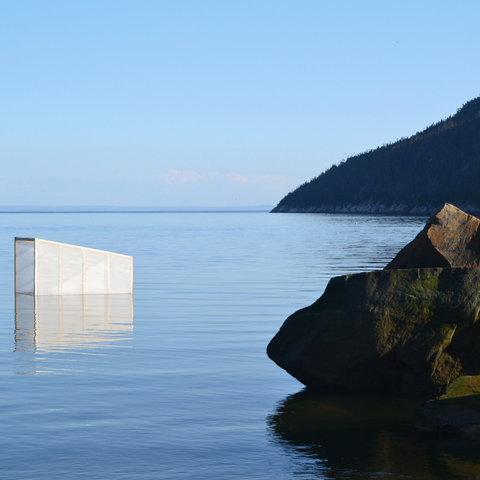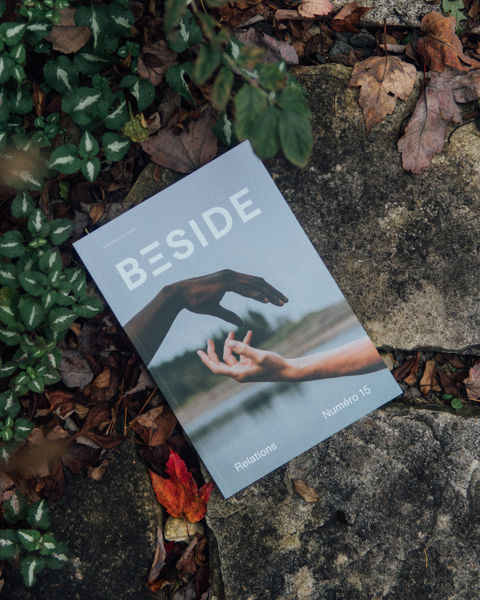The thaw isn’t sudden. Heat gains ground progressively instead of engulfing the entire room in one fell swoop. Time slows. All the senses taste something.
Now, more than 50 years later, the architect still remembers every detail of that golden moment in that cabin deep in the woods. Time has only reinforced for him the notion that "nature is our connection to beauty," an idea that has been central to Thibault’s work throughout his career. Nature is his laboratory, and through it, his creations reach for transcendence.
Thibault is definitely what one might call a "starchitect," and one of the only that Quebecers can rightfully call their own. He is sometimes considered the Frank Lloyd Wright of the North. Meeting him, it’s easy to understand that, for Thibault, architecture "is a lot more than putting up walls with a roof on top". It is, rather,"the space between the walls" which awakens the senses. Just like it did for Pierre when he was little, in his forest.
Architecture
A new space-time would also open up when the child would slip into his grandfather's Saint-Gervais barn in the Québec countryside. "I'd push open the door, I'd see light filter in through the cracks between the boards. A barn is at once simple and spectacular. With few materials, you could build big ones with very harmonious proportions. And they blended into the landscape so well!" In three sentences, he’s outlined the model for an ideal construction.
Thibault built his reputation designing his houses-as-landscapes, whose walls, instead of signalling a rupture, open onto the outside; and with an abundance of windows and a screened room or large patio that extend the living space into the "outside." These sober and sophisticated volumes are essentially contemporary variations of the traditional forest camp.
Rather than subject nature to human needs—like a more traditional architect-builder might do—Thibault's practice centres around respect for the environment: "architecture,” he says, “is revealing. I want to be like the insect that shows up and lands ever so lightly, moves a few things around a little bit, but especially, doesn't hurt anything."
His "Les Abouts" house, which stands at the far end of untilled farmland, is said to "synthesize the marriage between nature and culture," culture taken in its broadest philosophical sense.
And what better way to reveal this nature than horizontal lines bringing out the curves of the trees, mountains, sky or a lake? "When you insert a straight line, you immediately notice how graceful the organic curves found in nature really are. And that becomes a frame you create. The architecture emphasizes nature, and nature highlights the architecture.
The symbiosis between site and materials is very important," he stresses. Before figuring out how he is going to integrate his next creation into nature, he spends hours in the spot his clients have chosen. To bask in it, contemplate it—like the monks from Val Notre-Dame Abbey, for whom he designed a new monastery, at once modern and spiritual.
This slowness helps to understand and magnify the identity of the landscape. Thibault sits down like a "tiny grain of sand" to admire the thousand-year-old mountains, and how "the water and wind sweep the landscape".
While he remains humble, he is nonetheless aware of the mark his work will leave on the land—a legacy he doesn't take lightly: "Look around you. A container over there, rows of identical houses, deafening noise. Sometimes I have the impression some places become so ugly that people would rather close their eyes. We've become experts in ugliness."
Laboratory
The space-maker doesn’t hesitate to bring his students and collaborators on site, into the natural environments themselves, to help them build their own understanding of a place. Just like the little Pierre who built treehouses and snow forts, for the architect he is today, two dimensions just isn't enough.
His treehouses were on a different scale then, but the process was the same. "When we go off to create an installation in Grands-Jardins National Park, I'm still that little kid who wants to build his thing."
This spirit of naive exploration is important: it fosters the generation of new ideas, it leads to reinvention. With his teammates, the architect embarks on a quest for untapped possibilities in the greatest laboratory in the world: nature. When he prepares for cold-season excursions, his sense of adventure comes to the foreground: "There's going to be snow, we're going to the taiga, did everyone bring their sleeping bag?"
The trips he organizes leave a mark of minimalism on his projects. The installations he creates with his students and collaborators start from very little: materials or ephemeral structures for example, more than enough to "change perspectives", he believes. White fabric squares float on long poles against the winter whiteness. A workshop-in-motion deployed on a body of water, then another.

His "Les chambres blanches" project, in the famous Jardins de Métis along the Saint-Lawrence River, made of evanescent fabric creations enlivened by shadow play, was first developed in Montréal in collaboration with his students before migrating to this wide-open space where it settled for a few years. Gradually, these "rooms" became part of the scenery, appropriating space for themselves, while in turn, inviting visitors to make them their own.Some of the rooms are made simply of white boards, assembled into blocks that let light pass through narrow gaps. Others are more ephemeral installations. The interplay of colours, shapes, and light allows visitors to concretely "inhabit" the space, and appreciate the dialogue that opens between the built and natural environments. It’s an "encyclopedia of possibilities" printed into the minds of apprentice architects, he notes, which they can draw from, once they return to their university or workshop.
School
If we could see Pierre's inner landscapes, there would be the Saint-Lawrence River's horizon, the ebb and flow of its tides, an unfinished cabin that smells of cedar... and most likely a school shaped like a doughnut.
He discovered this school during a trip to Japan. It is built around a courtyard playground, flanked by luxuriant green roofs. His thoughts constantly return to it to feed his "best school in the world" project, which he has been mulling over for a long time and is finally getting the chance to work on. "When you travel, it elevates you, you see other things—and you see differently."
In North America, "schools feel like the parking lot of a Walmart. There's asphalt, a chain-link fence and a pile of brown bricks. And that's where life in society begins." We need to "let nature in," the architect insists, just like the Japanese have done with such ingenuity.
The Japanese have shown a real knack for urban planning, he says, which among other things, involves judicious placement of natural elements. But not just any element and not just any which way. On the other hand, North American suburbs showcase squares of grass and finely trimmed shrubbery, but the general feeling remains "plastic-like," he adds. Why not have a river run through it, or a winding park, to break monotony and encourage inhabitants to go for a walk? Like in Copenhagen, another one of the architect's favourite cities: "You see families getting around on bicycles. Its bike path network has become the most efficient in the world, and it wasn't at the expense of a single kilometre of highway. Can you imagine how happy the citizens are?"
Infrastructural solutions such as these might also allow us to better organize our cities. The Montréal area could contain the entire population of Canada if it had the same density as Tokyo, notes the architect. He waves his arms more emphatically when he talks about public spaces. "The tyranny of the ordinary" torments him; he blames people for not reacting against a "model that doesn't make any sense."
But when he gets too agitated, Pierre Thibault feels compelled to return to his house in the country and its cedar smell. To bask in the forest there or in ideas a little further afield, which will ultimately help grow a bit more beauty, a bit more happiness.








